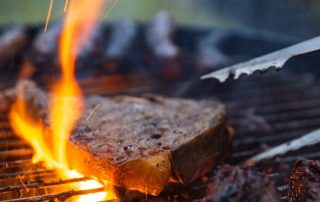Ideal cooking temperature
Beef, Veal, and Lamb Temperature Chart
Who doesn’t enjoy a perfectly prepared steak?
Check our temperature charts for preparing the perfect steak

Beef, Veal, and Lamb Internal Temperature Chart
It’s incredibly important to use a food thermometer when cooking beef, veal, or lamb at home. Nothing spoils a fantastic evening faster than an undercooked roast. To avoid hours of wasted prep and cooking time, use the below guide to cooking temperatures for beef, veal, and lamb.
How to Take the Temperature of a Roast: Place the food thermometer midway inside of the roast, away from the bones.
What is Carry-Over Cooking? We’re glad you asked! This is the process that occurs after any food is removed from heat. The residual heat causes the food to continue cooking for 5-20 minutes, which is known as carry-over cooking.
Through carry-over cooking, steaks can get up to 5°F-10°F (-15 to -12.22°C) higher after cooking because of residual heat. Roasts and whole birds can get up to 20°F (-6.67°C) higher than they were immediately after being removed from heat. It’s important to understand this process so you can cook your foods to a safe serving temperature without drying it out and overcooking it.
Fahrenheit and Celsius Cooking Temperatures
Internal Temperature Description
| Degree of Doneness | Internal Core Temperature in Fahrenheit |
Internal Core Temperature in Celsius |
Internal Description | More Information |
|---|---|---|---|---|
| Brisket | 203°F | 95°C | If the meat pulls apart easily, the brisket is ready to serve. | |
| Extra-rare or Blue (bleu) | 110°F to 120°F | 43°C to 49°C | deep red color and barely warm | feels soft and squishy |
| Ground Meat Patties – Meatloaf – Meatballs |
160°F to 165°F | 71°C to 74°C | For hamburger patties, insert the digital food thermometer through the side of the patty, all the way to the middle . | |
| Medium | 140°F to 145°F | 60°C to 63°C | center is light pink, outer portion is brown, and hot throughout | yields only slightly to the touch, beginning to firm up |
| Medium Rare | 130°F to 135°F | 55°C to 57°C | center is very pink, slightly brown toward the exterior portion, and slightly hot | yields only slightly to the touch, beginning to firm up |
| Medium Well | 150°F to 155°F | 65°C to 69°C | mostly gray-brown throughout with a hint of pink in the center | firm to touch |
| Pot Roast | 180°F | 82°C | If the meat pulls apart easily, the pot roast is ready to serve. Also called fork tender. | |
| Rare | 120°F to 125°F | 49°C to 51°C | center is bright red, pinkish toward the exterior portion, and warm throughout | soft to touch |
| Well Done | 160°F and above | 71°C | steak is uniformly brown or grey throughout | firm or hard to touch |










